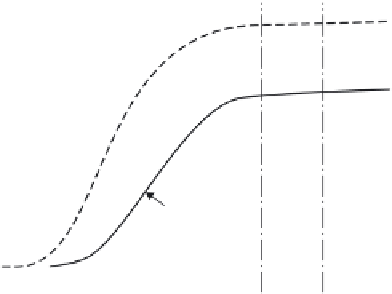Environmental Engineering Reference
In-Depth Information
Pressure vessel steel
DSA
Unirradiated
?
Irradiated
Temperature
1.23
Effects of neutron irradiation on fracture toughness and possible
effect of superimposed DSA.
32
the effect of neutron radiation exposure on DBTT or
RT
NDT
. However, a
lack of information on the fl uence dependence of
s
as well as other fac-
tors makes it rather diffi cult to apply the above formula in predicting the
changes in radiation embrittlement of nuclear pressure vessels. Radiation
embrittlement of ferritic steels is far more complex than using simple frac-
ture theory. The question now arises as to the superimposed effect of DSA
on fracture toughness and whether DSA adds to the increase in DBTT
(Fig. 1.23). Jung and Murty
33
examined the effect of neutron irradiation on
the elastic-plastic crack initiation fracture toughness (
J
IC
) using an unload-
ing compliance method before and after radiation exposure. Figure 1.24a
illustrates the effect of DSA on decreased fracture toughness in the DSA
regime which happens to be in the upper shelf region where we note a dip
in toughness. After irradiation the dip appeared at a slightly higher tem-
perature (Fig. 1.24b) illustrating the fact that neutron radiation exposure
results in reduced amounts of interstitial C and N atoms in solution and that
radiation does not eliminate DSA but postpones its occurrence to higher
temperatures. These synergistic effects of radiation-produced defects and
interstitials are sensitive to the composition of the steels.
34
σ
1.3.3 Radiation growth and creep
As we noted earlier in Fig. 1.12 voids and precipitates are generated in mate-
rials such as stainless steel during neutron irradiation resulting in reduced
density or increased volume known as radiation swelling that, in turn, leads
to dimensional changes even in the absence of external stresses. Zirconium







Search WWH ::

Custom Search